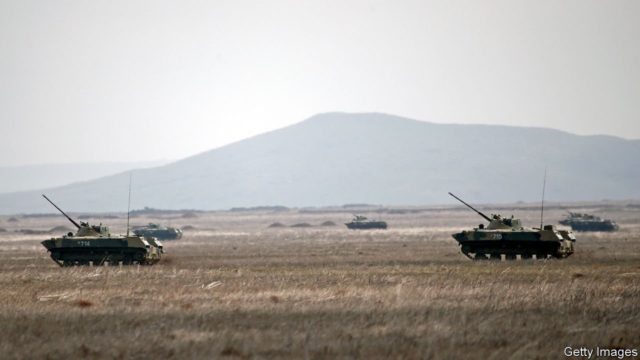
The Russian Military Buildup Around Ukraine: Bluff Versus Intention
Publication: Eurasia Daily Monitor Volume: 18 Issue: 185
By:

News of an apparent Russian military buildup around Ukraine has been attracting increasingly alarming international headlines since October (see EDM, October 14, December 2). These developments prompted regular statements from the leaders of the European Union and the North Atlantic Treaty Organization (NATO) regarding potential threats of an imminent Russian invasion of Ukraine as well as Western warnings to Putin about the serious consequences such a scenario would bring for Moscow. This message was also conveyed by United States President Joseph Biden during his video-conference with Russian President Vladimir Putin on December 7 (see EDM, December 8).
The concerns have been based on the confounding movements of Russian military units from the Central to the Western Military District in the spring–autumn of 2021. On May 31, Russian Defense Minister Sergei Shoigu actually said that 20 units and formations would be newly formed in the Western Military District by the end of the year to contain the perceived threat from NATO; but at that time, he did not disclose any further details (Interfax, May 31). This uncertainty created room for various assumptions and possible imagined scenarios.
International experts focused their analysis mainly on the units and equipment of Russia’s 41st Combined Arms Army (headquartered in Novosibirsk), which, in the spring, started relocating to the Smolensk-Voronezh area. These formations took part in the Russian-Belarusian Zapad 2021 joint military exercise, in mid-September; but they have not yet returned to their places of permanent deployment. This equipment, including Iskander short-range ballistic missile launchers, together with the maintenance staff, thus, remains at the outdoor storage bases in Yelnya, Smolensk Oblast. But more importantly, the redeployment of units of the 41st Combined Arms Army to the Western Military District continued in November 2021—that is, 1.5–2 months after the end of the Zapad drills (112.international, November 1; Janes, December 9).
It is becoming increasingly apparent that the Russian military leadership is implementing a plan to redeploy these units in the Western Military District on a permanent basis. Perhaps this is what the Russian defense minister had in mind in his statement on May 31, cited above.
According to Ukrainian military estimates, as of early December 2021, there were about 48 Russian battalion tactical groups in a 250-kilometer zone around Ukraine, including Crimea, totaling approximately 100,000 personnel. Most of these units are permanently deployed, including two new divisions in the 20th Army of the Western Military District in Belgorod (3rd Motorized Rifle Division) and Smolensk (144th Motorized Rifle Division) regions (Janes, December 9).
These divisions began to form back in 2016 and are still undergoing staffing and equipping. As such, the areas of their deployment have naturally become zones of increased military activity related to day-to-day movements and combat training (see EDM, November 8). This, in turn, has created much background noise, behind which it is more difficult to recognize signs of preparation for possible aggression against Ukraine from the northern direction.
In terms of the number of equipment and personnel, the largest surge in the grouping of Russian troops near Ukraine as a result of the transfer of units from other military districts can be observed in the 20th Army (Smolensk region) and Crimea. At the same time, the composition and size of the 8th Combined Arms Army on the eastern borders of Ukraine has not changed. This is notably the unit that supplies the 1st and 2nd Army Corps in the Moscow-controlled territories of the Donetsk and Luhansk oblasts in eastern Ukraine with equipment, ammunition and command staff (EuromaidanPress, December 3; Janes, December 9).
During the escalation of tensions with NATO in April–May 2021, Russia concentrated 53 battalion tactical groups and approximately 105,000 personnel in the same areas around Ukraine (see EDM, April 8, 22, 27). Therefore, it would be an exaggeration to speak of the unprecedented nature of the buildup of the Russian military grouping around Ukraine this fall. And in both cases, these groupings were not sufficient to launch a full-scale invasion of Ukraine, but they were enough for a limited operation to thwart any attempts by the Ukrainian Armed Forces to change the status quo in the country’s eastern oblasts.
The Ukrainian military is accustomed to periodic demonstrations of force by the Russian side and, therefore, is calmer about the current situation. Ukraine’s military leadership acknowledges the superiority of the Russian Armed Forces in airpower and missiles but believes that Russia is currently unable to provide the required force ratio for a successful combat operation against Ukraine. Major General Oleksandr Pavliuk, the commander of the Joint Forces Operation in Donbas, said that he did not see any signs that would directly indicate the possibility of immediate aggression: such as the creation of elements of a command-and-control system for an offensive, logistical and road preparation, or intensified reconnaissance in certain areas (Deutsche Welle—Ukrainian service, December 10). And in a further hint that the tensions may be gradually dissipating, on December 13, the Russian Ministry of Foreign Affairs reportedly ruled out any possibility that Moscow was preparing an invasion of Ukraine. According to Russia’s Deputy Foreign Minister Sergei Ryabkov “Americans are completely inexplicably obsessed with the idea that there is a threat of a ‘Russian invasion’ of Ukraine. This is not and cannot be. And what we are doing on our territory simply does not concern them, they have neither the moral nor the political right to ask such questions” (RIA Novosti, 112.international, December 13).
Thus, the current Russian military buildup around Ukraine is more likely to be a bluff and example of further psychological pressure on Ukraine and NATO rather than a genuine intention to invade.



